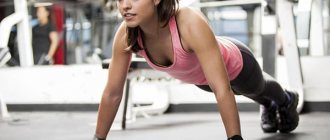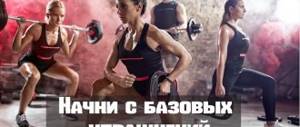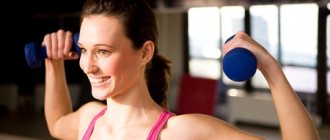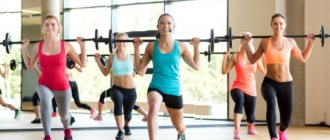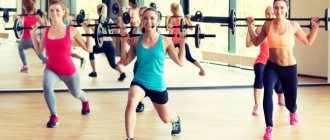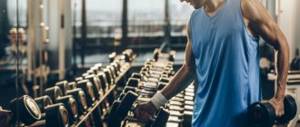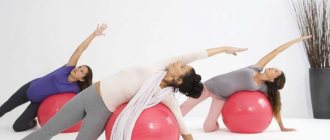Why strength training is so important
It has been proven that over time, without sufficient and regular strength training, muscle strength and size decrease. If a person does not maintain a sufficient level of activity, then after 20–25 years of age, on average, he loses 200–250 g of muscle mass in one year, and after 50–60 years of age, the loss doubles. Along with a reduction in muscle mass, bone density also decreases and metabolism decreases, which can negatively affect a person’s health.
By developing a habit of strength training, you can maintain optimal levels of muscle mass throughout your life. This healthy habit will not only help you stay in attractive physical shape, but will also reduce the risk of accumulating fat mass, the excess of which is associated with ailments such as atherosclerosis, metabolic syndrome, diabetes, etc.
It is worth paying attention to the fact that excessive involvement in strength exercises can bring not only benefits, but also harm, especially if the training program is drawn up without taking into account the individual characteristics of the trainee. Strength exercises involve working with both your own body weight and additional weight (dumbbells, barbells, kettlebells, etc.)
etc.), therefore this type of exercise puts additional stress on bones, joints, ligaments, as well as large vessels.
Before going to the gym, you should consult a specialist, especially if you have diseases of the musculoskeletal system, have previously had any injuries, have diseases of the cardiovascular system, or have ever sought help from a neurologist or psychiatrist. Beginners should also undergo a minimum medical examination.
To create an individual training schedule, you should hire a competent trainer who can assess your level of physical fitness and teach you how to perform the exercises correctly.
When lifting weights, it is very important to have someone to insure you.
Weight loss workouts
Weight loss occurs when more calories are consumed than consumed, so the main percentage of success depends on properly organized nutrition. Strength training, unlike cardio, allows you not only to burn calories, but also to maintain muscle mass. The principles behind strength training for fat loss are:
- Increasing the number of repetitions and reducing working weight.
- Reduce rest between sets.
- Including sets and supersets in your training, when several exercises are performed one after another without rest between approaches.
- Increasing the number of workouts during the week.
- Adding 20-30 minutes of aerobic exercise after performing strength exercises.
Strength training programs
With any program, at the very beginning, a warm-up is done before strength training. It will allow you to warm up your muscles and prepare them for the load. Stretching after strength training is also mandatory - it will relieve tension from the muscles and make them more elastic.
Training without weights
This program uses only the weight itself. Exercises for walking in it can be as follows: 1. Layer position with hands felt down. When performing, they jump, spreading their arms to the sides and moving their feet to the sides and lower to the floor in this position. During the second jump, they return to the starting position. Do the exercise 40 times. 2. Use some kind of elevation to perform it. They stand next to the last one, bend their knees, and move their arms back. They jump onto a hill, then jump back from it. Number of repetitions: 30.3. Run in place with slight bouncing and high raising of bent knees. Perform all 40 times. 4. Quick and continuous squats lasting 40 seconds. with throwing your arms forward. 5.10 push-ups from the floor with your hands while resting your feet on your toes and straight back. 6.10 jumping up from a squatting position with your palms resting on the floor. 7. Lying position with your back on the floor. 20 quick lifts of the torso and legs towards each other. In this case, one leg remains extended, the second bends at the knee, which is touched with the elbow of the bent opposite arm. 8. Rest your hands on the floor, your back is straight, your legs are extended. Alternately, take 10 steps forward with your feet with effort and return them back.
The benefits of strength training
First of all, moderate physical activity creates a harmoniously developed figure and improves health. A properly selected method of strength training strengthens the cardiovascular system, activates the body's metabolism, promotes weight loss and increased performance.
Well-developed muscles stimulate intense metabolism in the body, which affects overall well-being. People who exercise intensively look young and fit even at 40 years old. A poorly developed muscular system reduces the overall metabolism in the body and leads to premature aging.
If muscles do not perform their functions for a long time (lack of physical activity), then they are eventually replaced by adipose tissue. This leads to excess weight and a greater likelihood of injury. A poorly developed muscular system is not able to fully protect joints and bones from unexpected physical impacts. A simple fall on slippery ground can result in a ligament rupture or fracture.
A harmoniously developed body is the key to health.
Exercises for strength training
Before you begin an intensive strength training session, you need to set an end goal. If you have a clear idea of what result you want to achieve, then building a strength training plan is much easier.
Strength training programs for women differ in many ways from those for men. There is also a significant difference between strength training for weight loss and weight gain. Therefore, before starting a lesson using one method or another, it is necessary to consult with professional trainers.
The choice of strength training program also depends on where it takes place. If during strength training in the gym the set of exercises will include both work with free weights and exercise machines, then training at home introduces a number of restrictions.
Strength training at home
More often, strength training for home conditions is developed on the principle of using body weight. These complexes sometimes include exercises with dumbbells and a barbell. Strength training and running are often combined.
The advantages of exercising at home include:
- Possibility of training at any time;
- working with body weight and dumbbells develops overall coordination of the body and reduces the likelihood of injury;
- using music that you like during strength training;
- saving money.
Flaws:
- lack of instructor;
- there is no opportunity to work with heavy weights (lack of insurance);
- there is no opportunity to focus on working on a specific muscle group (lack of special equipment);
Working out in the gym
Beginning athletes should begin intensive training only under the supervision of experienced instructors. Each gym has specially trained staff who will allow you to soberly assess your capabilities and develop the necessary set of exercises based on this.
Regular classes in the gym are accompanied by constant monitoring of the process by instructors and assessment of your success. Based on the results achieved, changes are made to the set of exercises for strength training to promote the harmonious development of all muscle groups.
The presence of special simulators in the halls allows you to specifically work out one or another muscle group. Considering the fact that the body is in a fixed position on the simulator, the likelihood of injury is minimized. In addition, group strength training stimulates the athlete’s interest in achieving the desired result.
Regardless of what method you use, whether this process takes place at home or in the gym, the benefits of physical activity will be undoubted. But you shouldn’t immediately expect impressive results; you need to purposefully and systematically work on improving your body and remember - “A healthy mind in a healthy body.”
Especially for vesanet.com – Evgeniy
Features of women's training
Strength training for women has some features due to metabolism, the distribution of fat and muscle mass, the hormonal system, and the presence of the menstrual cycle.
The opinion that by training with heavy weights you can get a masculine figure is wrong. The female body produces tens of times less of the hormone testosterone, which is responsible for muscle growth, so women should not be afraid of strength training.
The most effective workout for losing weight is long-term aerobic exercise while keeping your heart rate (heart rate) level at the lower limit. Women are advised to avoid interval training.
The menstrual cycle also dictates its own rules. If your health allows, then training at the beginning of the cycle will be most effective. After the ovulation period, the female body begins to accumulate energy to bear offspring, and intensive training does not make sense.
Women are recommended to work on the upper muscles (back, biceps, triceps), high-repetition training of the legs and buttocks, a balanced diet with calorie counting and regular aerobic exercise.
What types of power loads can be used
Gymnastics that uses your own body weight to train muscles. This type of strength training is perfect for beginners, as it perfectly trains the main muscle groups and is quite enough to maintain optimal muscle strength. Examples of such exercises can be: various push-ups and pull-ups on the bar, squats and lunges, abdominal pumping, etc. This type of activity is ineffective for deep muscle training, but to maintain general tone and a flat stomach, ordinary gymnastics will be quite enough.
Working with a fixed weight. This training method allows you to strengthen all major muscle groups and involves the use of a fixed, small weight throughout the entire cycle of the exercise. For example, if you perform an exercise with 2-3 kg dumbbells to work the triceps (flexion of the arm at the elbow joint), then the weight of 2-3 kg remains constant throughout the entire training cycle. A light weight load is used to perform the exercises. These can be dumbbells, expanders and some types of exercise equipment.
Variable load allows you to work the muscles deeply and contributes to a faster increase in muscle mass. With this training method, the load changes directly during the exercise. Some types of machines use different incline angles and gravity to create different forces when lifting and lowering the weight.
What are the basic principles of successful strength training?
For effective muscle training, the load must be increased methodically, forcing the muscles to work harder and harder. The main task is to prevent the muscles from adapting to constant weight.
Variable load allows you to work the muscles deeply and contributes to a faster increase in muscle mass. With this training method, the load changes directly during the exercise. Some types of machines use different incline angles and gravity to create different forces when lifting and lowering the weight.
When strength training, you should pay attention to all major muscle groups. This is necessary for uniform increase and development of the muscle frame
Frequency: For most people, there is no need to do strength training every day. The optimal frequency is 2-3 times a week. Another option is to work on different muscle groups on different days. It is advisable that strength training alternate with cardio exercises. However, you should remember that by taking too long breaks between workouts, you risk not only slowing down the rate of muscle gain, but also losing the results achieved: the muscles will begin to weaken after 7-10 days.
How to choose the right weight?
Determining the starting weight level is a rather complex issue. If you have just started changing your life with the help of strength training, then be prepared for the fact that it will take some time to select the initial weight and intensity of work. The general principle is to focus on the feeling of fatigue. At the same time, when performing the last repetition, you should feel that the muscles are tired and loaded to such an extent that it is no longer possible to do another repetition.
The number of repetitions directly depends on what weight or load you are working with. For example, if you are doing an exercise to strengthen the triceps, then by extending your arms raised above your head at the elbow joint with dumbbells weighing 2–3 kg 10–15 times, you should not stop at exactly 10–15 repetitions, you should continue the exercise until you You will feel complete muscle fatigue and will not be able to do another repetition. The next time you perform this exercise, simply increase the weight of the dumbbells until you feel maximum fatigue by the 8th to 10th rep.
How many repetitions should you do?
There are two approaches, depending on what you want to achieve: build strength or increase endurance and tone. If you're looking to build strength, you should do fewer reps (8-10) with heavier weights. If you need to increase endurance and tone, then it would be better to perform more repetitions, but with less weight.
What is the optimal number of approaches?
Experts recommend performing 1-3 approaches, between which you should rest from 20 to 60, and sometimes 90 seconds. During your rest period, stretch your muscles, take a breath, and take a couple sips of water.
* Activates specific and nonspecific immunity
PHYSICAL EXERCISE SYSTEMS
⇐ PreviousPage 17 of 21Next ⇒Modern systems of physical exercises are a set of specially selected physical exercises aimed at a complex or selective impact on certain functional systems of the body.
Currently, the most popular among students are athletic gymnastics, rhythmic gymnastics, shaping, stretching, and oriental systems: yoga, wushu.
At the same time, it is worth noting that in compulsory classes in the academic discipline “Physical Education” it is necessary to use only those systems of physical exercises that provide increased motor activity.
Athletic gymnastics is a system of physical exercises that develop strength in combination with versatile physical training .
To develop strength, special strength exercises are used: exercises with dumbbells (5-12 kg), exercises with kettlebells (16, 24, 32 kg), exercises with a barbell (weight depending on training), exercises on simulators, etc.
Rhythmic gymnastics (aerobics) are sets of physical exercises, usually performed without rest at a fast pace to music.
Stretching is a system for developing flexibility and includes a set of exercises that help increase the elasticity of various muscle groups and mobility in the joints.
There are two types of exercises that stretch (muscle lengthening) when performed:
– ballistic – these are swinging movements of the arms and legs, flexion and extension of the torso, usually performed with a large amplitude and significant speed. Here, the lengthening of a certain muscle group is relatively short-term and lasts as long as the swing or flexion;
– statistical exercises are when a certain pose is assumed and the practitioner holds it for 5-30 and even 60 seconds.
It is static exercises with muscle stretching that are called “stretching”.
The physiological basis of such exercises is the myotatic reflex (stretch reflex), in which muscle fibers contract in a forcibly stretched muscle. As a result, metabolic processes are activated in the muscles, providing high vitality.
Yoga is a philosophical and religious system, which is based on the ability to control the psyche and physiological processes of the human body. Various “asanas” of yoga are not just the adoption of intricate poses, but a complex technique of body control, the purpose of which is to actively influence the respiratory system, internal organs and joint-muscular system.
Brief characteristics of some sports
Basketball
The game got its name from the English words “basket” - basket and “ball” - ball. Two teams of 5 people, subject to the rules, strive to throw the ball into the opponent’s basket using passes and maneuvering around the court, dribbling and feints, protecting him from shots into his own basket.
Points are scored for hitting the ball in the basket. For a successful shot into the basket during the game, the team receives 2 points, and for a successful shot made from behind the three-point zone - 3 points. For a successful free throw - 1 point. The team with the most points is considered the winner. In case of a tie, teams are given additional time to determine the winner.
In all classes, basketball matches last 4 halves of 10 minutes of net time (the stopwatch stops after each whistle from the referee). The break between halves is 10 minutes.
The rules of the game of basketball were first written down in the USA in 1891 by a teacher at Springfield College in Massachusetts, J. Naismith (1861-1939). These rules were published in 1894, which is considered the year the birth of basketball. The International Amateur Basketball Federation was organized in 1932. The World Basketball Championships have been held every 4 years since 1950 for men and since 1953 for women. Since 1936 Basketball is an Olympic sport for men and, since 1976, for women.
The game can take place in an open area and in a hall with a height of at least 7 m. The size of the field is 26x14 m. The backboard measures 180x120 cm from the stand. There should be 275 cm from the bottom edge of the shield to the floor or ground. The basket is a metal ring covered with a mesh without a bottom. It is attached at a distance of 0.3 m from the bottom edge of the shield. The circumference of the ball for playing basketball is 75-80 cm, weight is 600-650 g. Duration of the game is 40 minutes, 4* 10 minutes with a break of 10 minutes.
A basketball player has the right to move with the ball on the court, always hitting it on the floor. If he does not let go of the ball, then he has the right to take no more than two steps. After stopping, the athlete can no longer start moving with the ball again: the ball should be given to partners or made a throw around the ring.
In modern basketball, there is also a 30-second rule. Only during this time does the team have the right to possess the ball, and if the throw is not made, then the referees give the ball to the opponents. This rule increased the pace of basketball. Another time rule is the 3-second rule. An offensive player cannot remain in the opponent's free throw area for more than 3 seconds.
Volleyball
A sports game with a ball between two teams of six people each. Players of one team direct the ball through a net stretched over the court to the side of the other team so that it touches the court within its boundaries or is hit by the opponent in violation of the rules of the game.
In 1895, in one of the US colleges, Dr. William Morgan came up with a new game. He called it “volleyball”, which literally means “ball in the air” (flying ball).
In 1897, the same William Morgan proposed introducing rules for the game. At that time they were not at all similar to modern ones. The court had a size of 7.6 × 15.1 m, the height of the net was 198 cm, the ball weighed 340 g. The number of players was unlimited.
The first stage of development of volleyball dates back to 1895-1920. The game is demonstrated in front of an audience, and the players form teams. To avoid endless disputes and even fights, Morgan proposed installing a high chair, on which sat a judge, whose opinion became law.
Volleyball came to Europe in 1914-1917. Receives special recognition in the Czech Republic and Slovakia.
In 1922, the first official volleyball competitions took place in Brooklyn. After this event, volleyball was included in the program of the VIII Olympic Games, but the IOC rejected this proposal due to the insufficient number of participating countries. Volleyball gradually gained strength. The rules were improved and clarified, the number of players was limited to 6 people, the field size was 9x18 m, the net was installed at a height of 243 cm, the game was played to 15 points (taking into account a two-point advantage). The match was played in three sets, and to win it was necessary to win two of them.
In 1934, the first international volleyball commission was organized, which included 13 European and 4 Asian countries.
In 1964
Volleyball is finally included in the Olympic Games program in the Japanese capital Tokyo.
Since 1923, volleyball officially received “citizenship rights” in Russia.
1948 is the year the USSR joined the International Volleyball Federation. This year marks the beginning of the victorious march of Soviet volleyball on the international stage.
The volleyball court is limited by two side lines 18 m long and two end lines 9 m long. It is divided by the middle line into 2 squares. Parallel to the center line at a distance of 3 m from it, along each of the squares there are lines of attack, which I determine! attack zones. At a distance of at least 1 m from both side lines, net posts are installed on an imaginary extension of the center line outside the court. The upper edge of the net for men is 2.43 m, for women – 2.24 m. Ball circumference – 640-660 mm, weight – 260-280 g.
The ball may be hit with hands or any part of the body; contact with the ball must be abrupt and single. Violation of this rule is penalized with a point. Each team is entitled to three touches of the ball, but the defending team is entitled to four touches of the ball if one of them was on a blocker (a player who blocks the path of the ball with his hands).
The competition consists of three or five games, each of which continues (with the exception of game 5) until the team scores 25 points (tennis score), a score difference of 2 points is required. The 5th game is played up to 15 points; when one of the teams scores 8 points in the 5th game, the site changes. The serve is made from behind the end line from any point without crossing this line. The game begins with a serve through the net. Before you hit the ball, you need to throw it. A hit from the hand is considered a fault. Touching the net while serving is not considered a fault. If a team player puts the ball into play with a serve and the team wins a point, then the next serve is made by the same player. If a point is lost, the serve switches to the other side. After each serve played, players move from one zone to another clockwise.
The rules of the game do not allow: touching the net with any part of the body; cross the halfway line during the game; cross the baseline when serving; hold the ball when passing or shooting; do double strikes; make more than three blows on one side; You cannot block the passer.
The rules of the game allow: to move your hands over the net to the opponent’s side when blocking; perform an additional (fourth) kick after the ball touches the blocking players; touch the ball to any part of the player’s body.
Table tennis
Table tennis is a popular back-and-forth game all over the world. Competitions can be played by 2 to 4 people (singles or doubles). 2 players or pairs stand opposite each other at the table. The serve begins the point, and the ball must be sent to the opponent's playing half in such a way as to make the necessary return strike impossible.
Table tennis first appeared in Great Britain at the end of the 19th century. In our country, this sport became widespread in the 20s of the 20th century, then lost popularity and reappeared in the 60s. The International Table Tennis Federation was created in 1926, world championships have been held since 1926, currently every 2 years. In 1957, the European Table Tennis Union was created, which since 1958 has held European Championships every two years. Olympic table tennis competitions have been held since 1894.
The table measures 152.5 x 273.3 cm with a height above the floor of 76.2 cm. A dark green mesh with a height of 15.25 cm divides the table into two equal halves. The celluloid ball has a diameter of 40 mm.
The serve must be made in such a way that it is visible to the referee. It is carried out behind the back line of the table or its intended extension. The ball is thrown almost vertically from a flat hand and only then is it struck when it is in a downward motion. He must first touch the playing surface of the serving racket before he flies directly over or around the net to the opponent's playing surface. In a game, the change of serve occurs after 2 points are scored. The first player to score 11 points becomes the winner of the game. If the number of points is equal, the game is played 10:10 until one player achieves a two-point advantage. A point is gained due to an opponent's mistake. The game consists of 5 games.
Errors: repeatedly touching the ball on the playing surface, throwing the ball (into the net, behind the playing field), hitting the ball twice with one side, touching the playing surface with the body (except for the hand leading the racket) or the ball, touching the net, moving the table, missing a ball correctly sent by the opponent, serving illegally.
Doubles. The ball is sent diagonally from the service field to the opponent's service field. The server is determined by the choice made before the start of the first set. The first receiver is the next server and the partner of the first server is the next receiver, etc. After each game the serving order changes.
Playing table tennis develops speed, agility, coordination, endurance, will, and perseverance.
Mini football
In the 1920s last century, the game of football was very popular on Brazilian beaches (the field area, naturally, was much smaller than in big-time football). The beach version of the game with a small number of players was initially called “football de salon”. Soon mini-football entered the halls and acquired its own rules.
The first experimental game in Europe took place in 1958 at the Vienna Stadthalle. Gradually, mini-football gained popularity in other European countries. In 1988, its rules were finally approved, and in 1989, from January 5 to 15, a trial world championship in this sport was held in the Netherlands. In the final match, the teams of the Netherlands and Brazil met, which became the first champion.
The court and goal are half the size of regular football, and the ball is lighter. There are 5 players per team (goalkeeper and four field players). The duration of the game is two equal periods of 20 minutes. Before the start of the game, a draw is made to select sides of the court and the right to kick off. At the signal of the chief referee, one of the players begins the game by hitting a stationary ball lying in the center of the court, the ball must be aimed at the opponents' half of the court. All players must remain in their own half of the court, with the players of the team not taking the kick-off must be at least 3 m from the ball until the kick-off is taken. The player who took the kick-off does not have the right to touch the ball a second time before any of the other players. After a goal is scored, the game resumes in the same way as at the beginning of the game, by the team against which the goal was scored. Before the start of the second half, the teams change sides of the court. The ball is considered to be scored into the goal if it has completely crossed the line between the posts and under the crossbar and if, at the same time, a player of the attacking team did not deliberately bring in, throw in or push the ball into the goal with his hand. In the event of a six-meter kick, the duration of both halves is increased. Teams have the right to take one time-out lasting 1 minute in each half.
The player's uniform consists of a T-shirt with a number (players on the same team must have different numbers), shorts, socks, shin guards and shoes. It is permitted to play in training or gymnastic shoes with uppers made of fabric or soft leather and soles made of rubber or similar material. Playing without shoes is prohibited. The goalkeeper's clothing differs in color from the clothing of the players of both teams and the referees.
Athletics
Athletics is one of the oldest sports, combining running over various distances, jumping, throwing, race walking, as well as track and field all-around events.
The history of the development of athletics is continuously connected with the Olympic Games of ancient and modern times. At the first Olympic Games in 776. BC e. Only one type of athletics was played - running over one stage (approximately 192.27 m). The program of the modern Olympic Games includes 24 types of athletics for men and 14 for women.
In 1888, the first circle of running enthusiasts was formed near St. Petersburg. In 1908, the first Russian athletics championship took place. In 1912, Russian athletes, including 47 track and field athletes, competed at the V Olympic Games in Stockholm.
Athletics includes various types:
– short-distance running: 100 m run, 200 m run, 400 m run, 4×100 m relay run, and 4×400 m;
– middle distance running: 800 m run, 1500 m run; long and ultra-long distance running: 5000 m run, 10,000 m run, marathon run (42 km 195 m).
Marathon running gets its name from the town of Marathon. According to legend, after the Battle of Marathon (490 BC), a Greek warrior-messenger carried the news of the Greek victory over the Persians to Athens. Having come running, he announced his victory and fell dead. The marathon running competition is dedicated to this feat:
– steeplechase: 110 m hurdles (at a distance of 10 hurdles, the height of the hurdles for men is 106.7 cm, for women – 84 cm), 400 m hurdles, 3000 m hurdles (steeple- chase) (only men compete in this event; there are 5 wooden barriers 91.14 cm high around the stadium, and after one of them there is a pit with water);
– race walking: 20 km walk, 50 km walk (unlike running, race walking requires constant support on the pound);
– athletics jumping: high jump, pole vault, triple jump;
– track and field throwing: shot put (shot weight for men – 7.26 kg, for women 4 kg), discus throw, hammer throw, javelin throw;
– track and field all-around events: decathlon (only men compete in it). The program includes: 100, 400 and 1500 m running, 110 m hurdles, high jump, long jump, pole jump, shot put, discus and javelin throw. The competition is held over two days with five events on one day), pentathlon (for women, includes: 100 m hurdles, high jump, shot put, long jump and 800 m run).
Regular athletics contributes to comprehensive physical development and health promotion.
HISTORY OF OLYMPIC GAMES
The most authoritative and representative international competitions are the Olympic Games (summer and winter).
They originate from 776 BC. e. and were held in honor of the conclusion of a truce between Hellas and Sparta. At that time, sports competitions in Greece were organized in various places, but the most honorable were the Olympic Games, held in Olympia on the banks of the Alpheus River. The ancient Olympic Games were held until 394 AD. e., and a total of 293 of them were held. The games were held once every four years. The games originally included races over one furlong (192.27 m). One stage was equal to the length of the path, which, according to legend, Hercules himself determined in 600 of his feet .
Subsequently, the program of the games expanded and included running for 24 stages, wrestling, pentathlon “pentathlon” (running for one stage, long jump, javelin and discus throwing, wrestling), fist fighting, chariot racing, etc. Participate in Only freeborn Greeks could play games; slaves and women, as well as foreigners, were not allowed to compete. According to the conditions established for the participants, in preparation for the games they had to train for 10 months outside Olympia, and then 1-2 months in Olympia under the supervision of Hellanodics specially appointed for this - priests of the Temple of Olympian Zeus, to whom the games were dedicated.
During the games in Greece, a sacred peace was declared, which was strictly observed by the Greek city-policies.
The ancient Greeks had a good tradition: carving the names of the winners on marble columns installed along the Alpheus River. Therefore, we became aware of the date of the first Olympic Games and the name of the first winner - his name was Korab, he was a cook from Elis.
The modern Olympic Games arose at the end of the 19th century, a major role in this was played by the French educator and public figure Pierre de Coubertin (1863-1937), who in 1889 came up with the idea of reviving the Olympic Games. On June 23, 1894, exactly 1,500 years after the ban on the Olympic Games, the International Sports Congress was convened on his initiative. Congress decided to revive the games and create the International Olympic Committee (IOC). Pierre de Coubertin (1895-1925) was elected President of the IOC.
“Olympic ideas mean friendship of peoples, mutual understanding and peace,” wrote Pierre de Coubertin. The Olympic Charter embodies these ideas; it proclaims: “The goals of the Olympic movement are to promote the development of those excellent physical and moral qualities that are acquired in competitions on the friendly fields of amateur sports and to unite the youth of the world every four years at a great sports festival, creating thereby building international trust and goodwill and contributing to the creation of a better and more peaceful world...” The Olympic Oath states: “On behalf of all athletes, I promise that we will participate in these Olympic Games, respecting and abiding by the rules under which they are held, in a true spirit of sportsmanship, for the glory of the name and honor of our teams.”
The first Olympic Games of our time took place in 1896 in Athens, the birthplace of the ancient Olympic Games. At the first games there were 13 countries that competed in 9 sports. At the II Games there were already 20 countries and they competed in 18 sports. As a sign of the merits of Pierre de Coubertin, the Non-Olympic Games were held in Paris in 1900. For the first time, women participated in them.
For the first time, a Russian team of 5 people participated in the IV Olympic Games in London in 1908. At the VI Olympic Games in Stockholm in 1912. Tsarist Russia sent a team of 169 people.
In 1951, the National Olympic Committee (NOC) was created in the USSR, which is recognized by the IOC. Soviet athletes were sent to the VI Olympic Games in Helsinki (Finland) for the first time in 1952. In the overall team competition, our athletes shared 1st and 2nd places with the US team and have since begun to perform successfully at the Olympic Games.
The XXX Olympic Games were held in Moscow in 1980. Since the 80s, the commercialization of sports has become widespread in the international Olympic movement (the Olympic Games in 1976 brought losses to Montreal in the billions of dollars, and the games of the 80s and 90s turned out to be profitable). In 1974, the IOC adopted the “Amateur Regulations”, allowing athletes to receive financial assistance, and essentially allowing the professionalization of Olympic sports.
One of the fundamental requirements of the Olympic Charter, that only amateur athletes can take part in the games, has radically changed. Currently, there is practically no division of athletes into amateurs and professionals in terms of admission to the Olympic Games.
The Winter Olympic Games begin their history in 1924. However, the first competitions in winter sports, held in 1924 in Chamonix (France), were not yet called Olympic, but were called international sports week. The question of the Winter Olympic Games was again discussed at the IOC session in 1925, where they received an official call. Soviet athletes began competing at the Winter Olympics in 1956 at the VII Winter Games in Cortino d'Ampezzo (Italy). The first gold medal for our country was then won by Leningrad student Lyubov Kozyreva, who won the 10 km ski race.
Thus, sport is an integral part of physical culture, the specific feature of which is competitive activity itself and preparation for it with the desire of those involved to achieve high sports results.
⇐ Previous17Next ⇒
Didn't find what you were looking for? Use Google search on the site:
Cheat, but without cheating
In general, you should strive to do exercises in strength training purely without deception (we deceive ourselves), but there is a situation when some conscious “rounding of the corners” helps. For example, you are already tired, but the target muscle group, in your opinion, has not yet received the necessary stimulation. In this case, you can use a slight “cheat” by throwing the projectile upward (passing the weak point in the concentric phase) not entirely cleanly and, thus, excluding the weakest muscles from the work. In strength training this is called “cheating” from the English. cheat – “fraud, deception.” So, cheating is used exclusively in the last few repetitions and, precisely, with the aim of achieving muscle failure. In all other cases, cheating is harmful and traumatic. It is especially not recommended to cheat for those who have not yet learned how to perform the exercises correctly, otherwise they will never learn it and will continue to cheat all their lives.
Pumping the pectoral muscles
The chest muscles are divided into two groups:
The superficial layer covers the outside of the chest and includes:
Subclavian, pectoralis major, serratus anterior and rhomboid muscles.
Deep layer:
External intercostal, internal intercostal, internal, subcostal muscles, transverse thoracic muscle, levator ribs.
Now we can talk a little about the most effective exercises. There are many different exercises for the chest, but we should not forget about the most important ones, the basic exercises.
Strength training equipment
You can do strength training: - without additional weights at all (for example, do pull-ups, push-ups); - with a minimal set of weights (dumbbells, weights, barbell); - using a large number of different weights, special exercise machines.
Equipment for strength training can be: - for weights and resistance - barbells, dumbbells, weights; - exercise machines: - strength: they can be mechanical, pneumatic, gyroscopic, hydraulic; as an example - Smith frame; – gymnastic: they are represented by harnesses, balls, TRX loops, rollers; - for fitness: there are many of them, they, for example, can be exercise bikes, treadmills; - sportswear: athletes, when performing exercises, use vests, overalls, gloves, shoes, hips; all of them should be comfortable, not be an obstacle to movement; - devices: used to simplify and conveniently work with weights: most often they use belts, straps, backpacks, belts, chains; - in special training they use, for example, an Indian bat, a balancing board .
Inventory
After training, the equipment used must be disassembled and stored in specially designated places. This is necessary for the training of the athletes who come after you, and you yourself will not run around and look for lost exercise equipment and weights.
Strength exercises at home
Each exercise develops a certain muscle group, your task is to correctly distribute the load on all the muscles of the body, that is, you need to adhere to a certain system, a training program that will help develop muscles proportionately and make the body stronger.
For leg development
- front thigh - squats with dumbbells
- biceps berd - deadlift with dumbbells on straight legs
- quadriceps, gluteal muscles, hamstrings - lunges with dumbbells
- buttocks, muscles of the back of the thigh and quadriceps - stepping onto the platform
Developing a strong and broad back
- for the lower back muscles – deadlift with dumbbells
- for the latissimus dorsi - pull-ups on the bar with a wide grip (4x8, 3x12, 5x6, ladder)
- dumbbell row
For the development of pectoral muscles
- pectoralis major muscles - dumbbell press lying on a horizontal bench
- middle and inner edge of the pectoralis major muscle - arm raises with dumbbells lying on a bench
Exercises for developing hands at home
- mass, volume and strength of the biceps - lifting dumbbells for biceps while sitting/standing
- triceps mass and strength - reverse push-ups
- biceps and brachialis – hammer with dumbbells
- middle (peak) of the biceps - concentrated biceps curl
- inner (outer) part of the forearm - extension (flexion) of the arms at the wrists with a dumbbell (forward/reverse grip)
Triceps muscle development
- Bent-over/overhead dumbbell extension/standing dumbbell French press
- triceps/pectoralis major/front deltoids - dips
Exercises at home to develop strong and broad shoulders (deltoids)
- front and middle deltas – dumbbell press while sitting on a bench/ lifting dumbbells in front of you/ Arnold press
- rear delts - bent over dumbbell raises
- middle delts - dumbbell lateral raises/standing dumbbell raises
Exercises to develop your abs at home
- oblique abdominal muscles - oblique crunches
- Lower Abs – Hanging Leg Raises/ Hanging Knee Raises/ Reverse Crunches
- upper abs - crunches
The above list of exercises that can be performed at home with just dumbbells must be streamlined, that is, you cannot do all the exercises at once in one day, as many beginners do out of ignorance (you will get nothing but overtraining).
Powerblock Kettlebell Push-Up
Fitness strength training exercises for all muscle groups. The benefits and harms of fullbody training
Fullbody style training allows you to develop your entire body evenly. With their help, you can build up a basic “reserve” of muscle mass, which you will develop and strengthen later.
They are suitable not only as intensive programs for training in the gym, but also for those who want to exercise effectively at home. That is, you don’t have to plunge headlong into the world of sports - such a system will give you a chance to keep your body healthy and strong.
Training different muscle groups on the same day is perceived by the body as serious stress. When you train your chest, legs, and back in one session, this actively stimulates your metabolism. As a result, such workouts are very good for losing weight.
Such an integrated approach can only cause harm if you seriously violate the technique of performing an exercise, or if you train too often, not allowing the body to recover.
Training complex
Before you start strength training, you need to do a warm-up. This will allow the muscles to tone and avoid injuries and sprains.
Depending on which muscle groups are loaded, the following types of exercises are distinguished:
- lumbar arches;
- squats;
- pull-up on the horizontal bar;
- deadlift;
- standing barbell row to the chin (broach);
- bent over row of the barbell to the waist.
Lumbar arches
- Take the starting position - lie on the bench with your stomach down, fix your heels.
- Place your hands behind your head.
- Lift your torso up so that your head is above your buttocks.
- When performing this exercise, the muscles of the back, buttocks and thigh biceps are worked, including.
Squats and pull-ups
Squats put stress on the muscles of the thighs and buttocks. Beginners can perform this exercise without additional load. Subsequently, you can use the barbell as a load, placing it on your shoulders
When performing this exercise, it is important to follow the correct technique: maintain an absolutely straight back and move your pelvis back. Otherwise, the entire load will fall on the knees and joints, which can result in complications.
Doing pull-ups on a horizontal bar at home is only possible if you have a simulator. When performing this exercise, more than one muscle group is worked - biceps, triceps, chest and back muscles. In order for the exercise to be as effective as possible, you need to lower yourself to the point of outstretched arms and rise until your chin stops at the horizontal bar line.
Deadlift
The deadlift is an exercise that requires a barbell to perform. The technique is as follows:
- Take the starting position, placing your feet on your shoulders and keeping your back straight.
- With your back straight, bend over so that your body weight rests on your heels and your pelvis is pulled back. Under no circumstances should you bend over with a round back.
When lifting, the barbell should slide over your legs. When it is at the level of the knee line, you can straighten your back, gradually bringing it to a straight position
It is equally important in this exercise to lower the barbell correctly. The speed of execution is not as important as the correct technique, so you need to carefully monitor the sliding of the bar along the legs and the position of the back at this time
Since the deadlift is a rather complex exercise in terms of technique, it is recommended that you at least watch a training video before performing it.
Barbell row to the chin
The barbell row to the chin while standing forces the muscles of the shoulder girdle to work. To perform the exercise correctly, the barbell is taken with a narrow straight grip and, with the help of the shoulder muscles, rises up to the level of the chin, while the elbows must be spread to the sides.
In order to pump up your shoulders as much as possible, you can use a wide grip on the barbell when performing the exercise. Rowing a barbell to your waist strengthens your back muscles and improves your posture. The technique is as follows:
- Grasp the barbell with a medium straight grip (at shoulder width).
- Bend forward, arching your back; The body weight should remain on the heels.
- Pull the barbell to the stomach to the level of the lower ribs.
It is important not to swing the body or change its position, rigidly fixing its tilt, not to round the back and wrists, and point the elbows back
Exercises with dumbbells
In addition to the barbell, it is useful to have dumbbells or weights in your home arsenal. There are several options for using them. With them you can do:
- squats;
- hammer;
- bench press;
- traction;
- exercises targeting specific muscle groups.
Dumbbell squats are similar to barbell squats. The essence remains the same - have a strong back, arch in the lower back and feel the weight of the body on the heels.
The Hammer exercise has this name because of the similar movements when working with a hammer: the arms are raised to shoulder level in turn.
At the same time, it is important not to swing the body and not move the elbows away from the sides. Execution pace is slow
The bench press is performed lying with your back on a bench. You should spread your arms with dumbbells to the sides so that your elbows are approximately at the level of the bench or slightly lower. Making sure that your hands are in the same position relative to each other, raise them up and lower them to the same level.
To perform the deadlift exercise with dumbbells, you will need a horizontal bench. You need to stand on it with your right knee and lean on it with your right hand. The left leg stands on the floor, the left hand with the dumbbells is lowered down. Pull your left arm to waist level and change sides.
Training conditions
Honestly, I have no idea where you plan to study. If you have a gym membership, then “all the cards are in your hands.” Well, if at home, then again I won’t be able to accurately predict what kind of sports equipment you have. Maybe you have a horizontal bar? Or a whole Swedish ladder with attachments (beam, bars)?
I would dare to suggest that people planning to exercise at home have in their arsenal collapsible dumbbells or ordinary weights of different weights - it seems to me that this is a mandatory minimum. Perhaps someone has their own personal mini-gym with at least one bench, a bar and a set of weights, dumbbells, block machines and squat racks.
In addition, I often say in my articles that full-fledged sports equipment can be replaced with homemade or improvised ones for those who have just started exercising and do not need large weights for weights.
I will try to label exercises that will be more suitable for home use. Naturally, I will not name those that can be done in the gym - this is a matter of course.


